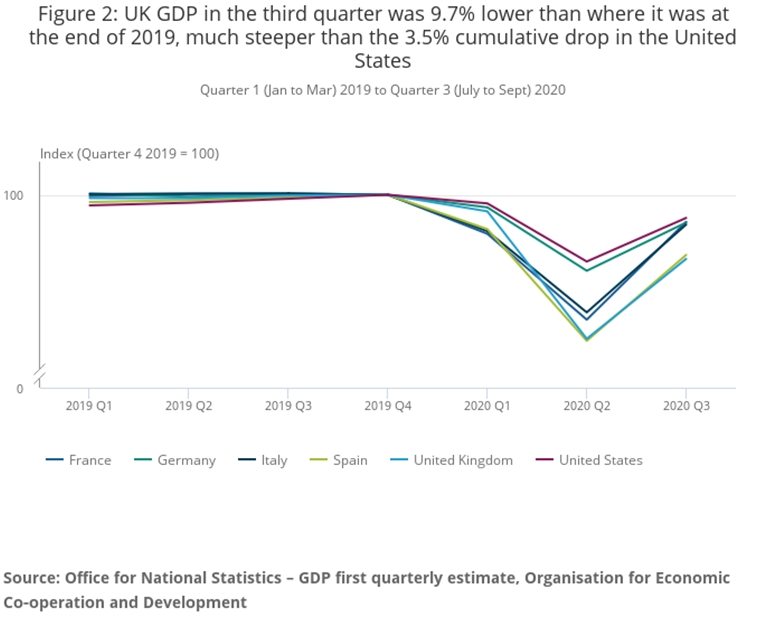By Michael Burke
The experience of this country (both positive and negative) and many others shows that there should be a compete lockdown to combat the pandemic. This means all non-essential work stopped, all leisure and other services halted, schools closed and all possible higher education moved online. There should also be proper compensation for workers, who should receive 100% of their pay, not the 80% currently (or none at all for some freelance and other workers). That compensation should be for the duration of the furlough itself, at first approximately 8 weeks and until new cases reach levels where they can be suppressed, and then extended for the necessary period while the gradual back to work process is completed.
A combined crisis
The public health crisis caused by the Covid-19 pandemic has led in turn to an economic crisis. There is no possibility of ‘saving the economy’ while a pandemic is raging. Services account for approximately 70% of the economy and the demand for many of these is discretionary. You cannot force people to go to pubs, cinemas or restaurants in a pandemic. On the experience of this country and many others, the majority of people will simply refuse to take up their normal leisure and cultural activities. It is not the restrictions that are killing these businesses and workers’ jobs. It is the pandemic itself.
Similarly, there is no ‘trade-off’ between combatting the virus and protecting the economy, as ministers and others frequently claim. The UK’s own disastrous record on both demonstrates that. The UK has one of the worst death tolls per capita of any large country in the world, and the worst total in Europe despite both waves of the virus hitting this country later than continental Europe. It has also the worst economic performance any major Western economy (see Chart 1 below).
Chart 1. UK GDP, Largest Contraction Among the Major Western Economies

By contrast, it is clear that all the countries that have effectively eliminated the virus are also the economies that will grow the strongest this year, as shown in Table 1 below.
Table 1. IMF Real GDP Growth Forecasts for 2020
| Country/Region | Real GDP Forecast, % |
| China | +1.9 |
| Viet Nam | +1.6 |
| USA | -4.3 |
| EU | -7.6 |
| UK | -9.8 |
Source: IMF World Economic Outlook
At the same time there is a public health imperative to combining full lockdown with full pay for all furloughed workers. Many workers are already in poverty even at 100% of their usual pay. Excluding pensions, most benefit claimants are people in work and 56% of those in poverty before the pandemic were in work. Put simply, millions of a were already poor when being paid at 100% of their wages. Reducing it to 80% increases the probability of outright destitution for millions.
The pay cut also compels many to ignore lockdown restrictions, even when they know they are putting themselves and their loved ones at risk. 80% of breadline wages is insupportable. People are then forced to seek additional work, in breach of the requirement to close all non-essential workplaces. It is morally unjustifiable to cut those wages, including those on the National Minimum Wage, as this government is doing. It is in the interests of the whole of society that people are able and do adhere to strict lockdown measures.
‘There is no money left’
The main objection to 100% pay for all furloughed workers is cost. But the additional outlay for full pay is tiny in comparison to other levels of expenditure, including a £300 billion bank loan guarantee scheme and the initial £110 billion support for businesses (via the Job Retention Scheme, the bounce back loan scheme, the business rates holiday and other measures).
The estimated cost of the initial furlough scheme which ran from March to the beginning of October was £40 billion. Using simple maths, the total cost of a scheme offering 100% of wages is only marginally more at £50 billion. Of course, the government cap can continue to apply at £2,500 pay per month.
The National Institute for Economic and Social Research (NIESR) estimates that the scheme is self-funding. This is because over the long-term it helps to preserve jobs and all the tax revenues that they generate. Furlough payments are like an insurance policy, helping to ensure the continuation of that future tax revenue stream dependent on jobs.
But the furlough scheme, and increasing it to 100% of pay, is also largely self-financing even in the short-term. Over the period of the first half of the Financial Year (FY), which approximately coincides with the bulk of the initial furlough scheme from April to the end of September, government revenues declined by £42.6 billion. As the biggest contributors to tax revenues are from personal income taxes and indirect taxes on personal consumption, it is clear that government revenues are lowered by reduced employment and reduced pay. So, in the first 6 months of this FY, taking just VAT, income tax and social security together, government revenues fell by £23 billion compared to the first half of the last FY. The shortfall would be even greater adjusted for inflation.
The increase to 100% furlough pay is easily affordable.
It would also be an important part of a genuine lockdown, which could break the back of the virus as has been done elsewhere (and which was almost done here until lockdown was ended too early in June).
There may be a more valid objection about fairness, especially for essential workers who would continue at work even during a properly effective lockdown. But that should be dealt with in other ways, such as large bonuses and substantial above-inflation pay rises when the pandemic is finally ended.
The labour movement should argue for 100% of pay in a complete lockdown. Full lockdown and full pay now!


Recent Comments